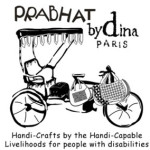1992: Society for Child Development was set up to provide quality education for children with disability from extremely poor families living in the slums of North Delhi.
2000: When the students of the Society for Child Development’s Prabhat special school grew into young adults, the specter of creating a market driven facility with a clear mandate of ensuring economic viability loomed large, especially as the working group consisted of an administration that had specialized in healthcare management, trainers who were used to dealing with children with intellectual disability, but in the confines of a school environment, and trainees who were non-verbal and barely able to care for their own needs. In addition, the popular view that the goal was unattainable meant that financial support was nil.
We also realized that in order for the en masse education of children with disabilities, avenues for later life development – livelihood, income generation – would have to be created.
Since there were no examples of sustainable employment practices with this group to model upon, it was left to the management to develop a strategy. Logically it appeared that it would be desirable to develop:
The challenges were many, with the lack of financial resources topping the list. With no money to purchase raw material, training was difficult as the inevitable wastage of raw material led to financial losses. Given the fact that persons with intellectual disabilities are very slow to learn, it was estimated that procurement of raw material without any output would not be sustainable given the economic landscape of the organization. Thus, the choice naturally narrowed to the use of material that could be donated regularly, such as unused and unusable items from households, offices and manufacturing units to fabricate handcrafted items for personal, household and office use. This program was titled the Trash-to-Cash Livelihood Program.
On till 2010: Between the inspiration and the decision and the final course of action, the search was on a set of skills that were based on the key requirements of low-cost technology and repetitive process led to India’s tradition of weaving. The looms were purchased from the local market and then modified to ease some of its complexities. To enable skill development a simple learning loom has also been designed in-house. This proved to be successful and is now used in production in the central hub and the outreach centers.
The rest followed – videotapes and audiotapes began looking like boxes of yarn, waste flowers created visions of glorious colors, waste fabric yielded yards and yards of patchwork and everything else went into the melting pot of paper.
Thus, the Trash-to-Cash unit has a group of 46 adults with intellectual disability who create the basics – hand woven fabric, sheets of paper, dried petals for dyeing and powders and so on.
2014: The hub started taking shape with a production team comprising 164 skilled people who are hearing impaired, visually impaired or physically challenged take over to make the final product – bags, coasters, folders, and conference items. Women with disability form the core of this section. Most of them have some basic skill in tailoring, and honed on-the-job. The group is inclusive with 25% “able” but educationally and economically deprived persons.
2015: We take flight into other regions and the Central hub doubles as a design lab for process strategies, inclusive p roduct designs and business development.
roduct designs and business development.
Yet another dynamic collaboration with French designer Dina Fourneret with the label … Prabhat byDina.
2017: Fast forward to the current year …. reaching overseas in our first trade show …. NY NOW in New York city!